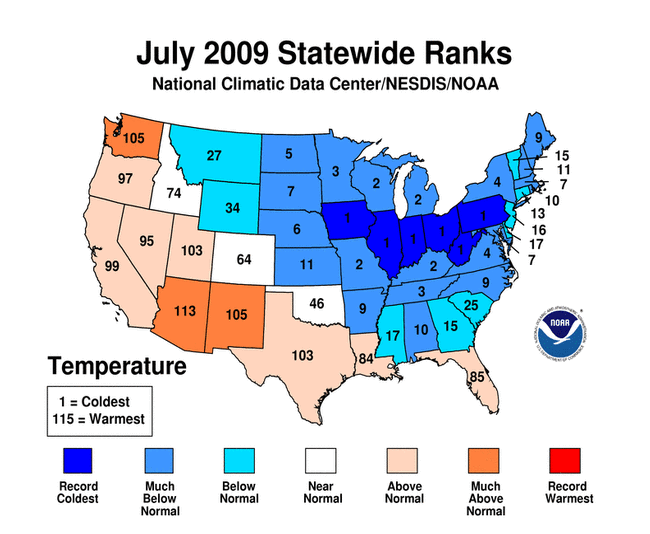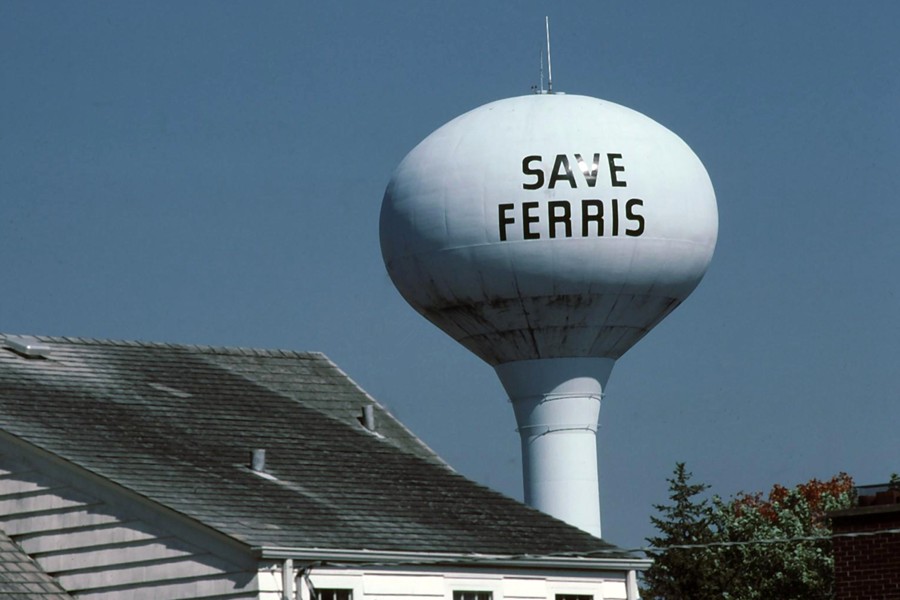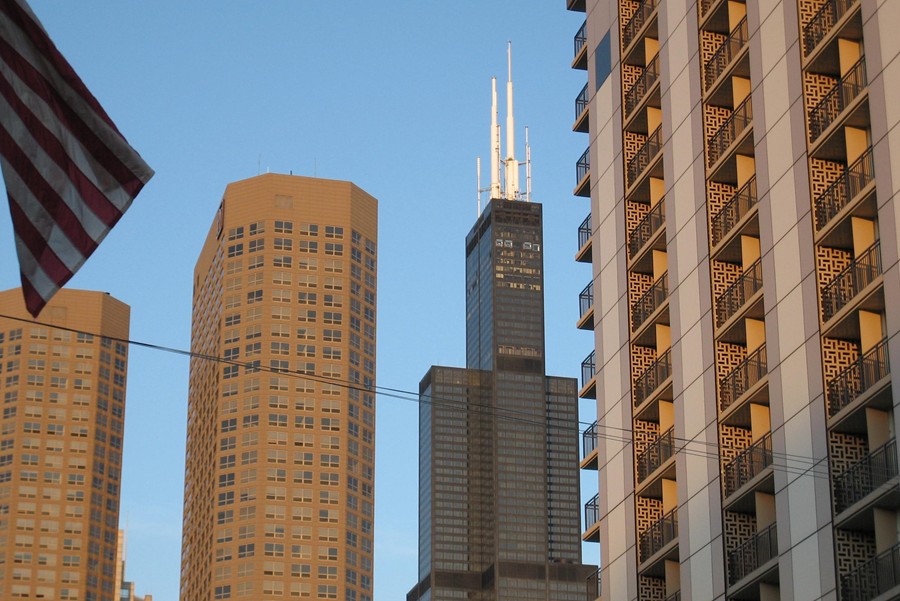I got so caught up in Parker Day yesterday I forgot to mention this bit of history:
[A] century ago Tuesday, on Sept. 1, 1909, State and Madison Streets became the base line of a new citywide grid system that changed virtually all addresses and also formed the basis for the street systems of many suburbs.
[Before then, t]he winding, bending Chicago River was the original start of the grid, but that meant addresses weren't consistent because they weren't based on a straight line, said Tim Samuelson, the city's cultural historian. When buildings were added, the city sometimes gave them numbers out of order. Street names were duplicated throughout the city, such as Lincoln Avenue and Lincoln Place.
The grid system means getting lost in Chicago takes a great deal of effort.
The Encyclopedia of Chicago has more:
The renumbering of Chicago's streets in 1909 and 1911 obviously required a great deal of preparation. Residents needing to notify correspondents of a new house number could find a variety of preprinted postcards in styles ranging from humorous to decorative to matter-of-fact. The August 21, 1909, Record-Herald headlined an article, "Postcard makers Reap Harvest on Change in City's House System."
Besides postcard makers, mapmakers also saw a dramatic rise in business as a result of the new system. This 1910 Rand McNally map shows that every eight blocks on the grid (starting from State Street and moving west) marks a major thoroughfare.
Getting someone's address in Chicago, therefore, becomes just a question of cross-streets. "I'm at 1060 W. Addison," someone says, and all you need to know to get there is, "What hundred north?" (3600, for those unfamiliar with the location.)
In fairness to cities where, for example, West Fourth and West Tenth intersect, Chicago got to start its street system from scratch—twice. Still, it does make living here seem that much more rational.
Via Gulliver, a new study of taxes levied on visitors to U.S. cities finds Chicago in the lead:
The study provides several different views of travel taxes to help readers make informed choices. The top 50 markets are ranked by overall travel tax burden, including general sales tax and discriminatory travel taxes, and by discriminatory travel tax burden, excluding general sales taxes to count only taxes that target car rentals, hotel stays and meals. Separate data are offered for central city and airport locations, as the tax regimes are often distinct.
No word on cities overseas, though the story does mention that some cities tax visitors indirectly at much higher rates.
The U.S. Postal Service finally plans to sell the Old Post Office building in Chicago, which they abandoned more than 10 years ago:
One of the biggest real estate auctions in the city’s history is slated for Thursday, when the U.S. Postal Service is to sell the Old Main Post Office.
And even though the postal service is planning an "absolute auction" — meaning the building is to be sold regardless of price, with a suggested opening bid of just $300,000 — the question remains who will step up for the roughly 279,000 m² building at 433 W. Van Buren St., which straddles the Congress Parkway and has been vacant for more than a decade.
This is the same building into which the Postmaster for Chicago ploughed $1 million to renovate his own office—about 6 months before the USPS moved out.
As sleep deprivation and other physical assaults continue here in London, and as we begin a five-day sprint through all of Financial Accounting, I pause to note one of the bigger news stories from back home in Chicago. No, not the Cubs sale to the Ricketts family or United's and American's shared panic; I mean the alligator in the Chicago river:
A 3-foot-long alligator was caught in the Chicago River last night and is en route to a more suitable home, according to a spokesman for the Chicago Commission on Animal Care and Control.
Animal Care and Control called the Chicago Herpetological Society, which sent two people in a canoe last night to set traps for the reptile.
All right. I can deal with that. Moving on...
The Chicago Tribune reported this afternoon that the Red, Yellow, and Orange Lines have gotten approval for long-overdue extensions—or, in the case of the Yellow Line, restoration:
The Red Line extension, some 40 years in the making, would use Union Pacific Railroad right of way. The new train service would improve mobility for low-income residents in communities under-served by mass transit on Chicago's South Side, as well as provide a new transit option for commuters from the southern suburbs who either drive downtown or drive to Metra stations.
In addition, the Orange Line would be expanded from Midway Airport to near the Ford City shopping center. The extension is intended to improve bus-to-train connections for numerous CTA and Pace bus routes along Cicero Avenue and other nearby parts of the Chicago area where there has been significant growth. ... In the north suburbs, the Yellow Line would be extended several miles to near the Old Orchard shopping center in Skokie, from the current terminal on Dempster Street.
I say "restoration" for the Yellow Line because, until 1963 when the North Shore Line went bankrupt, the line ran a bit farther than Dempster Street. Actually, it ran all the way to Milwaukee. But because public preference and policy favored private cars over all other forms of transportation, the northern suburbs expanded through road construction, to the detriment of the existing interurban rail lines that covered the area. The Yellow and Purple Lines run over the North Shore Line's tracks, in fact.
That the CTA now wants to restore 5 km of track that existed for 60 of the past 100 years was predictable when the track was removed in the 1960s. I wonder how long it will take before the Yellow Line goes up to Northbrook Court. Again.
The National Oceanic and Atmospheric Administration has published its climate highlights for July 2009:
- An abnormally strong, persistent upper-level pattern produced more than 400 record low minimum temperatures and 1,300 record low maximum temperatures (lowest high temperature) across the nine-state area that make up the Central region.
- Ohio, Iowa, Illinois, Indiana, West Virginia, and Pennsylvania experienced their coolest July on record. Kentucky, Missouri, Wisconsin, and Michigan each had their second coolest July on record, while Minnesota and Tennessee had their third coolest July on record.
And they have art:

After Illinois passed a tough anti-corruption law in the wake of Rod Blagojevich's implosion, the Federal Highway Administration found it ran counter to U.S. law:
[T]he General Assembly passed a bill making it illegal for the governor or any agency he controls, like the Illinois Department of Transportation, to award a contract to any person or entity that donated more than $50,000 to the governor's campaign fund.
[S]tate Sen. Don Harmon (D-Oak Park) and the House sponsor of [a second bill that lifted the cap on IDOT projects], Rep. John Fritchey (D-Chicago), say they had no choice but to weaken the anti-corruption law because the feds told them they had to or Illinois could lose zillions in federal highway funds.
"However laudable the goals of such state laws, they have the effect of limiting competition in the awarding of federal-aid highway contracts," says the May 9 letter from FHWA Acting Deputy Administrator Jeffrey Paniati. Putting a brick on the proposals in Illinois and Jersey — which arguably is just as corrupt as Illinois — was "necessary to ensure compliance with federal law," the letter said.
Now, wouldn't it be an interesting twist, and typically Illinois, if the legislature passed the $50,000 cap to throw contracts to friends of the legislature instead of friends of the governor....
Nah, they're not that sophisticated, are they?
From June to October 1985, my home town looked like this:

(Don't you) forget about John Hughes.
Yesterday around sunset I found myself driving down Halsted St., just west of the Loop. Here's the Sears Willis Tower and Presidential Towers:

Usually I hate July weather in Chicago. Not this year. We ended up with the coolest July in my lifetime (at Midway), and also one of the driest, making for an unusually pleasant month:
Chicago's 69.4-degree average July temperature at O'Hare International Airport was the coolest of the past 17 years. But at Midway Airport, the month's 71-degree average temperature was the site's coolest in 42 years. Estimates based on the month's temperatures suggest the need for air conditioning was 30 percent below the long-term average.
The month's lack of rainfall was impressive -- and a huge change from the wet spring that kept farmers out of their fields. Only 1.53 inches of rain was measured here in July, less than half the 3.51 inches considered normal.
One symptom of this: O'Hare recorded only one day in which the temperature hit 30°C, and Midway only two, while here at Inner Drive Technology Worldwide Headquarters the lake's proximity kept it even cooler than that.
But this doesn't mean it was ever cold, either. Just pleasant. I sure will miss it this week: the forecast calls for warmer, wetter weather until the middle of the month.